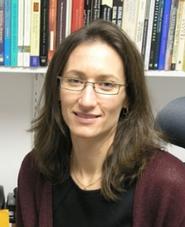
Breena Holland, associate professor of political science and the environmental initiative at Lehigh University, takes a different approach to academic research than many of her colleagues. While many faculty succumb to the “publish or perish” research first nature of their profession, Holland is less interested in massive data driven studies and more concerned with the real world impact of her work. That’s why much of her time has been spent conducting research intended to directly benefit underprivileged members of Lehigh’s local community of Bethlehem, Pa. Holland was a guest speaker in the Levitt Center Sustainability series on Feb. 7.
Once renowned as the home of the nation’s second largest steel maker, Bethlehem now suffers from economic hardship and some of the highest rates of air pollution in the United States. Holland is particularly concerned by the high rate of childhood asthma in the city, which is 17 percent higher than the nation’s average and even higher in the area surrounding the dilapidated remains of the Bethlehem steel mill. Interestingly, Holland notes that the city’s high rates of air pollution are unrelated to the presence of the steel mill’s remains, but rather are indicative of more subtle pollution trends.
During its operation from the late 19th century to the 1950s, the Bethlehem Steel Mill emitted vast amounts of PM10 particulate pollution, a sooty substance that was so prevalent it would leave a layer of dusty on laundry hung out to dry at homes near the mill. Today’s asthma inducing airborne contaminate, PM2.5 particulate pollution, is much smaller than PM10 and thus invisible to the naked eye; however, it is just as dangerous as the smog of years past. PM2.5’s is made up of a number of pollutants, the most significant of which is black carbon, a small speck of organic matter surrounded by heavy metals and other toxins. Black carbon’s microscopic size makes it small enough to pass through the body’s natural pollution filters, called cilia, and often goes unnoticed by those who are exposed to it.
Holland points out that the problem of black carbon pollution is not unique to Bethlehem – dozens of counties across the United States fail to meet EPA standards for PM 2.5 – but that recent economic developments and the city’s location in a valley (which prevents pollutants from dissipating) have worsened the problem. The pollution itself results primarily from the exhaust of cars and heavy diesel vehicles, and the recent opening of the Sands Casino in Bethlehem at the site of the old mill has worsened this problem to the tune of two million cars and 38,000 diesel buses per year.
Holland has opposed the casino since it was granted a construction permit in 2006 on the grounds that the pollution brought about by increased traffic disproportionately affects low income residents living in the vicinity of the casino and thereby violates their right to “environmental justice.” Holland has fought to revoke the casino’s permit to provide parking and has argued in favor of a shuttle service to transport patrons to the casino from parking areas outside the city, but Bethlehem officials have been unswayed by her arguments, citing the much needed tax revenue and jobs that Sands provides to the city.
In the face of these obstacles, Holland has begun an effort to better understand black carbon and how it can be avoided by the city’s residents. After obtaining funding for $20,000 worth of black carbon air monitors, Holland and her undergraduate researchers began to measure black carbon levels at various intersections throughout the city. They discovered that while black carbon is often present in many times the EPA maximum quantity level along major thoroughfares and intersections, the particulates dissipate quickly and are almost non-existent in areas of the city that experience less traffic. In an effort to use this knowledge to benefit members of the Bethlehem community, Holland and her student researchers worked with young asthma sufferers from underprivileged households to create new low PM2.5-exposure walking routes that the students can take to school.
While Holland’s project has been the subject of much success, she emphasized the further need for concern regarding the environmental justice of minority and low income community members. She believes that the extensive financial and academic resources colleges and universities have access to present the potential to influence great change, and that comprehensive academic studies can give environmental regulators the evidence they need to successfully pursue larger agendas of environmental justice.
Posted February 8, 2013
